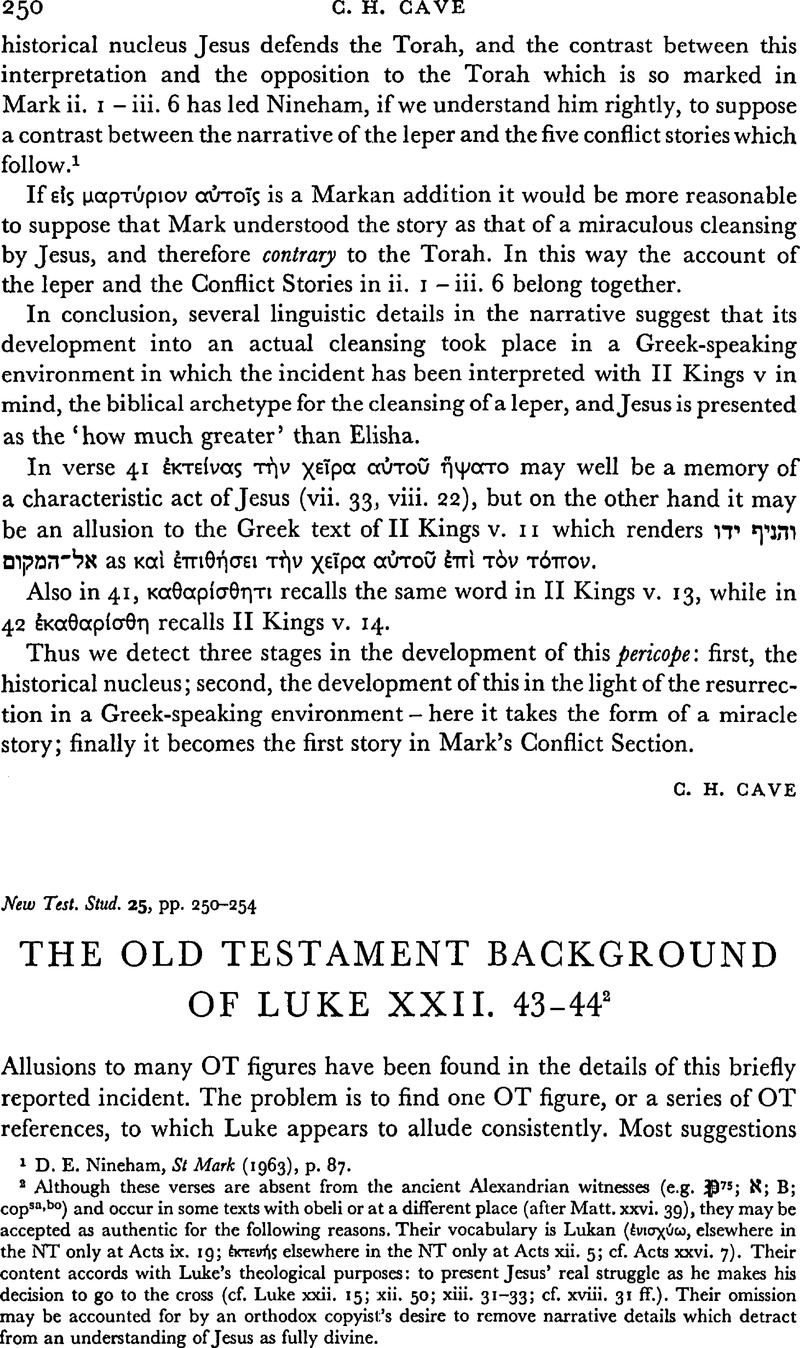No CrossRef data available.
Published online by Cambridge University Press: 05 February 2009

page 251 note 1 Selwyn, E. G., The Oracles in the NT (London, 1912), p. 367.Google Scholar
page 251 note 2 Baldwin, E. St G., ‘Gethsemane: The Fulfillment of Prophecy’, Bibliotheca Sacra 77 (1920), 431.Google Scholar
page 251 note 3 Dibelius, M.: ‘Gethsemane’, Botschaft und Geschichte: Gesammelte Aufsätze (Tübingen, 1953), 1, 270.Google Scholar
page 251 note 4 Loisy, A., L'Evangile selon Luc (Frankfurt, 1971), p. 528Google Scholar; Javet, J.-S. (Commentaire de L'Evangile de Luc (Geneva, 1957), p. 253Google Scholar) says the agony reminds one of Abraham's trial (Genesis xxii); Justin (Dial. 103. 7–8) identifies the bloody sweat as the fulfilment of Ps. xxi(xxii). 15, the heart melting as wax; Dibelius (Botschqft, 1, 270) is not convinced.
page 251 note 5 Hinnebusch, P., ‘Jesus, the New Elijah, in St Luke’, Bible Today 31 (1967), 2178.Google Scholar
page 251 note 6 Downing, J., ‘Jesus and Martyrdom’, J.T.S. n.s. 14 (1963), 289Google Scholar; cf Grundmann, W. (Das Evangelium nach Lukas (Th.Hk., 2nd ed., 3; Berlin, 1961), p. 412)Google Scholar, who also mentions the Jewish exegetical tradition that it was Michael the angel of the Lord who strengthened the three martyrs in the fiery furnace (Gen. R. 44 on Gen. xv. 7); Dibelius (Botschaft, 1,270) compares the angel incident with the voice from heaven to Polycarp (Martyrdom of Polycarp, 9.1); cf. John xii. 28–30.
page 251 note 7 Loisy, , Luc, p. 528.Google Scholar
page 251 note 8 Navone, J., Themes of St Luke (Rome, 1971), p. 123 n. 20.Google Scholar
page 251 note 9 With regard to the contention that Jesus' agony is presented as a martyr's suffering, Barbour, R. S. (‘Gethsemane in the Tradition of the Passion’, N.T.S. 16 (1969–1970), 239Google Scholar) observes that Luke of all the evangelists hardly presents Jesus' suffering in his passion in so graphic a way that it could be fairly described as a martyrological struggle.
page 252 note 1 Hinnebusch, , Bible Today, 31, 2181.Google Scholar
page 253 note 1 Contrast Hooker, M. D. (Jesus and the Servant (London, 1959,) p. 162)Google Scholar, who argues that the Isaianic Servant figure was not the OT background for either Jesus' or Luke's understanding of Jesus' Messianic mission. She suggests that the suffering of the saints of the Most High as well as the glory of the Son of Man in Daniel is the proper background to Jesus' self-understanding. While her findings with regard to the lack of Isaiah influence may be questioned on methodological grounds (cf. France, R. T., ‘The Servant of the Lord in the Teaching of Jesus’, Tyn. Bull. 19 (1968), 26–52)Google Scholar, it is interesting to note that she fails to deal with either the significance of ένισχύω in Daniel, Isaiah, or Luke; or the fact that the willing obedience of the suffering Servant has no explicit parallel in the description of the saints who suffer.